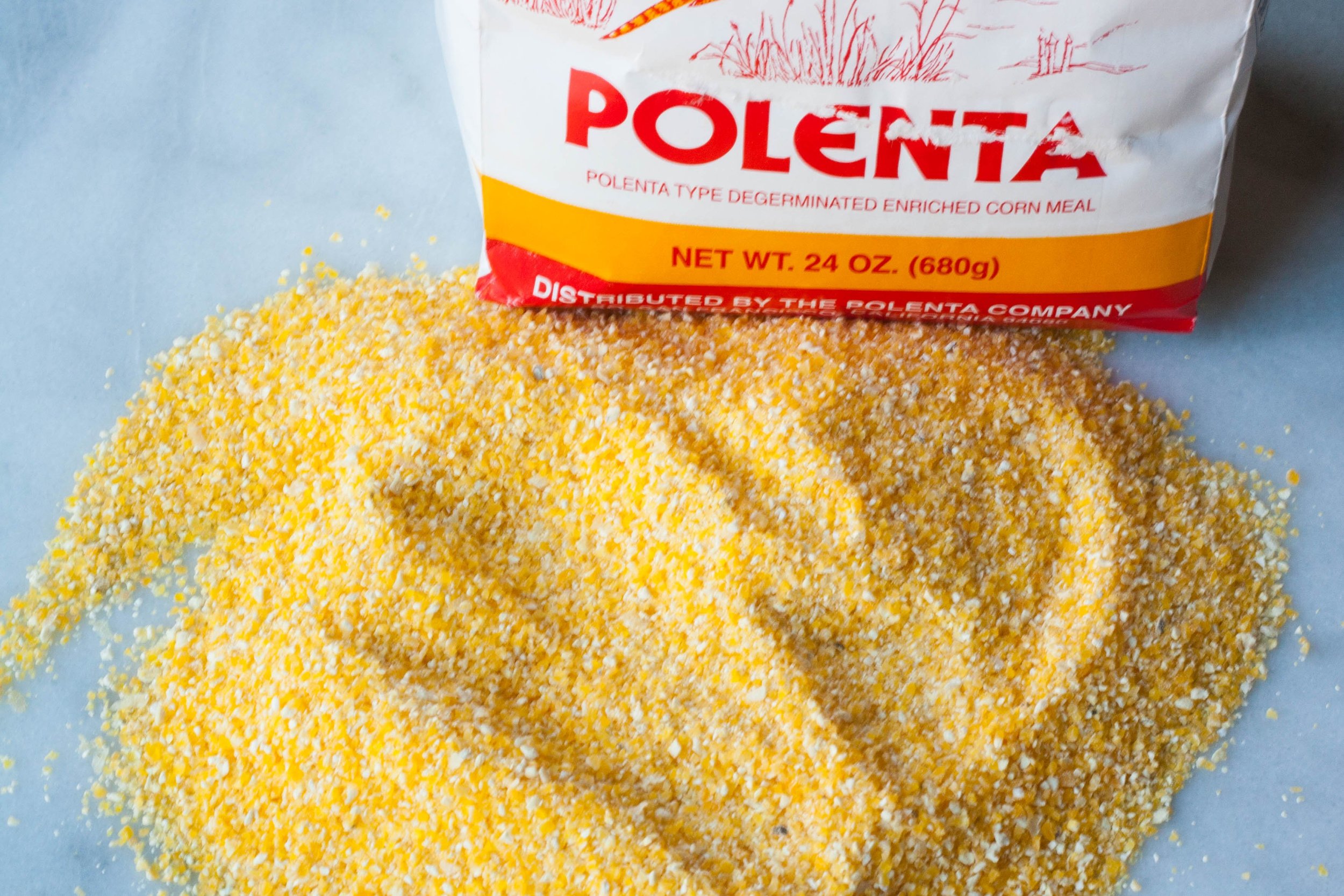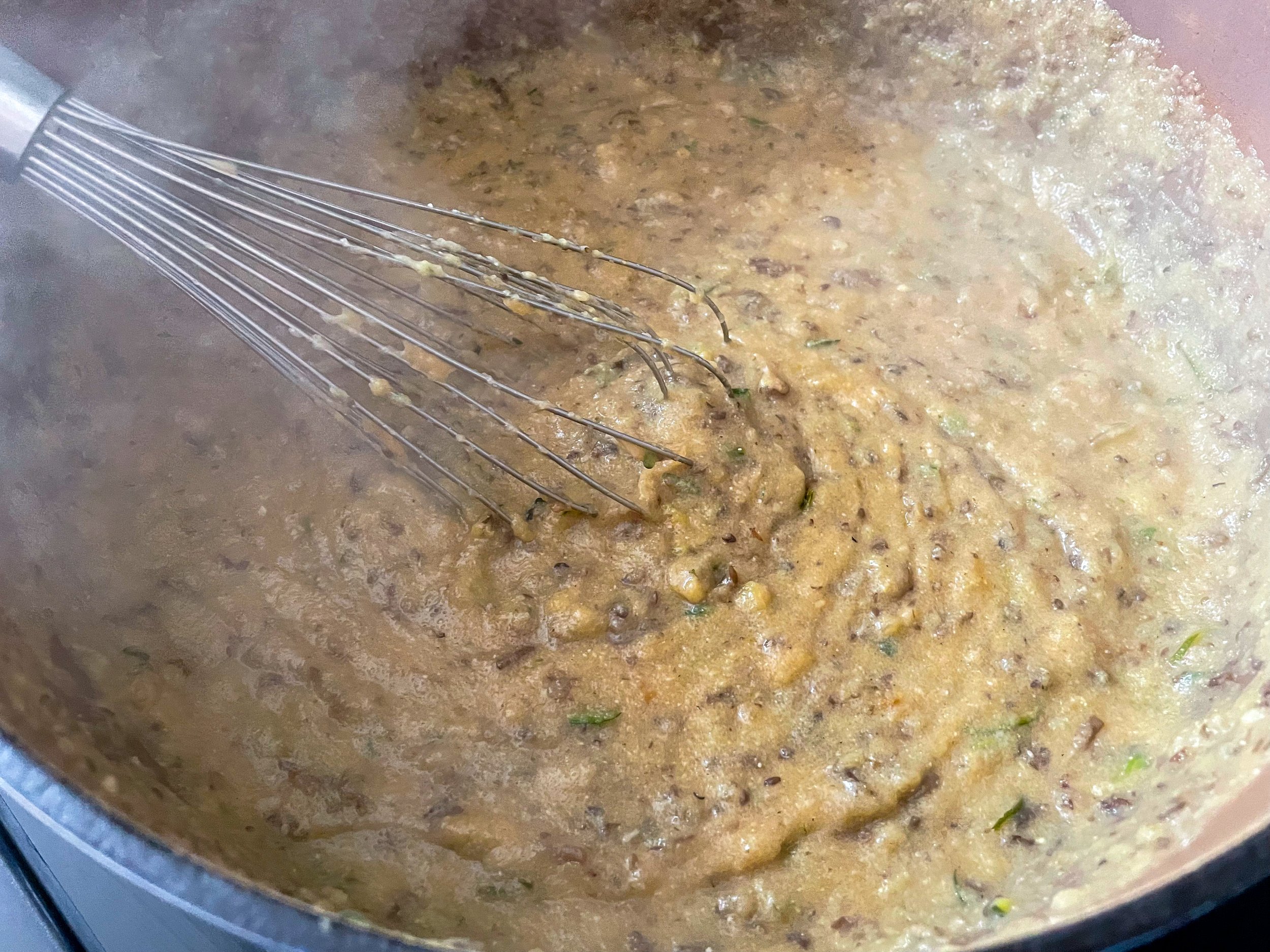Creamy Mushroom & Zucchini Polenta
This unctuous plate of creamy, silky, cheesy polenta is the MOST comforting side dish for cold winter nights. Grated mushrooms and zucchini are delicately flecked through the polenta to add incredible flavour and colour to the dish. Serve this rich, velvety side dish with a simple roast chicken and buttered green garden peas.
In this super easy side-dish, I saved time by grating mushrooms and zucchini with my food processor but you can easily do this with a box-grater. If you prefer large pieces of veggies, you can go at it with a knife and practice your knife skills! Adding mushrooms to this dish adds an earthy, deep flavour to the polenta and pairs amazingly well with lots of parmesan cheese ad ground black pepper.
Believe it or not, the perfect ration for making the creamiest polenta is 6:1. By using 2 cups of milk plus 4 cups of good chicken stock to one cup of fine-ground polenta, you’ll achieve the perfect consistency every-time.
If you are feeling extra, get your hands on some truffle paste or truffle oil and stir a good drizzle through the warm polenta right before serving.
What is Polenta?
Polenta is an Italian staple, now made with white or yellow ground cornmeal. Polenta can be served many ways, most popular being as a warm, creamy porridge or cooled and cut into shapes to be fried, baked or grilled. If you haven’t tried polenta fries, you’re missing out!
As with most things delicious, polenta has very humble roots. Polenta was traditionally associated with the lower class in Northern Italy. This porridge was considered la cucina povera, literally translated to “poor kitchen”. The Ancient Romans would have made polenta with many different starches before the introduction of corn from North America in the 16th century. This dish was essential in the nutrition of the lower classes and was a very filling option when times were tough.
It’s important to choose the right polenta for what dish you are making. Use fine ground polenta for a soft and creamy texture like in this dish. For firm polenta, you’ll want to use coarsely ground polenta.
Step 1
Prep your ingredients.
2 tablespoons extra-virgin olive oil
1 onion, finely chopped
1 large zucchini, grated (2 cups grated)
1 lb cremini mushrooms, grated (2 cups grated)
1.5 tablespoons garlic, minced (about 4 cloves)
1/4 (60 ml) cup dry white wine
4 cups (1 L) chicken stock. Homemade or store bought works. Look for a low-sodium option or get some from your local butcher shop.
2 cups (500 ml) milk (I used skim but anything works)
sea salt, to taste
black pepper, freshly ground, to taste
2 tablespoons butter (optional)
grated parmesan cheese, to taste (optional)
1 bunch fresh chives, finely chopped (optional)
Extra-virgin olive oil or truffle oil (optional)
Step 2
Heat the olive oil in a large sauce pan over medium-high heat. You will need a pan large enough to comfortably hold about 4 litres of liquid.
Heat the oil until it is shimmering but not smoking.
Dump the chopped onions into the hot pan and stir to coat the onions in oil.
Step 3
Fry the onions until they are golden brown and caramelized. This step will add a nuttiness and some sweetness to the polenta.
Stir the onions every-so-often to make sure they don’t burn.
Step 4
When the onions are caramelized, pour in the grated mushrooms, garlic and zucchini.
Step 5
Saute the veggies until they are slightly browned and the pan is almost dry of moisture.
Cooking the veggies down like this creates a beautiful base flavour that packs a punch in the final product. The earthy mushrooms and green zucchini are su delicious in this dish.
Step 6
Pour the white wine into the veggies. The wine should boil-up immediately. Use a wooden spoon to scrape the bottom of your saucepan. Scraping up the brown bits is an essential step for maximum flavour in the final product.
Use a white wine that is dry, not too sweet. You’ll want that acidity to balance out the richness of the polenta.
Step 7
Pour in the chicken broth and milk.
I used homemade chicken broth, but if you don’t have any handy, use a low-sodium option. Alternatively, head to your local butcher and buy from them. A butcher will likely have their own homemade stock that will be delicious and rich.
We drink skim milk at home, so that’s what I had, but you can use whatever you have. The higher the fat content, the creamier the result.
Step 8
Bring the whole lot to a boil.
Step 9
When the liquid is just boiling, pour in the polenta all at once.
Turn the heat to the lowest setting.
Step 10
Whisk the polenta into the liquid until everything is smooth and no lumps remain.
Cover the pot and simmer the polenta over low heat for 15-20 minutes. Whisk the mix every 5 minutes to prevent the bottom from burning.
Be VERY careful when lifting the lid as polenta tends to spit at you and could burn you.
Step 11
When the polenta is cooked, it should be thick but soft and creamy. The individual grains should be tender and not grainy when tasted.
Step 12
Take the polenta off the heat, season with sea salt and freshly ground black pepper. Stir a couple of tablespoons of butter through the polenta for extra richness and flavour.
Serve!
Serve the polenta hot, topped with freshly grated parmesan cheese and finely chopped chives.
If you are feeling extra fancy, drizzle some extra-virgin olive oil or truffle oil over the polenta. Truffle oil, or truffle paste will smack you in the face with earthy umami flavour and really make this into a stand-alone dish.


















